- Author: Jeannette E. Warnert

However, a team of UC Cooperative Extension and UC Davis scientists have found that low-quality tap water in some rural immigrant communities could be an obstacle to making this healthy dietary change.
The study was conducted in conjunction with a five-year research and outreach project underway in Firebaugh and San Joaquin, small communities in the San Joaquin Valley with high Mexican-American populations. The researchers are investigating whether a community-based intervention – involving nutrition education, a monthly voucher of $25 to purchase fruit and vegetables, and a physical activity program – can help prevent childhood obesity in Californians of Mexican descent living in low-income rural communities. UC Agriculture and Natural Resources and UC Davis were recipients of a $4.8 million National Institute for Food and Agriculture grant to carry out this research.
Twenty-seven mothers in the study shared with the researchers whether they use tap water and gave their perceptions of tap water quality. In addition, the researchers assessed local water quality by the frequency of violations reported by Cal EPA and contaminant-level data from the California Department of Public Health.
All 27 mothers said they avoid drinking tap water due to unpleasant taste, dirty or yellow appearance, excessive iron or general “contamination.” Most of the women rely instead on bottled, and to a lesser extent, home filtered water for drinking and cooking.
“This cost is an extra burden for these families, many of whom have limited incomes,” said Lucia Kaiser, UCCE specialist in the Department of Nutrition at UC Davis.
The mothers shared in interviews that at least 38 percent of their children aged 3 to 8 years old drank sugar-sweetened beverages – such as soda, energy drinks, powered drink mixes or fruit punch – more than two or three times per week.

Two state-regulated water systems serve the majority of people in Firebaugh and San Joaquin. The rest rely on at least 11 small public or private systems. All of the 13 systems have had monitoring violations in the last 12 years. Two have had reporting violations, indicating that they either did not test for contaminants or did not report their findings.
The mothers' perception that tap water was unappealing or contaminated was confirmed when the researchers took a close look at regulatory analyses reports from previous years. There were low-levels of arsenic detected, which fell above the benchmark for safe drinking water in the U.S. The analyses also detected high levels of manganese and iron, which are considered secondary contaminants and do not have enforceable limits set by the EPA. However, the World Health Organization has set health benchmarks for manganese, which were exceeded in some samples.
“The neurotoxic effects of manganese and chronic exposure to low levels of arsenic warrant further study,” Kaiser said. “Even if it's not dangerous, the high level of manganese and iron can give the water an off taste.”
Regardless, removing the contaminants may not matter if perceptions and drinkability are not improved. A possible solution is better communication.
“A simple step could be sending easy-to-understand water quality reports to all residents,” Kaiser said. “Sending reports to renters in addition to property owners and in Spanish as well as English will help raise awareness about the safety of local tap water.”
The study was funded in part by the UC Davis Center for Poverty Research, which developed a two-page policy brief outlining the research findings. UC Davis doctoral student Caitlin French was the main author. Other contributors, in addition to Kaiser, were post-doctoral researcher Rosa Gomez-Camacho, UCCE nutrition, family and consumer sciences advisor Cathi Lamp and UC Davis nutrition professor Adela de la Torre.
In the policy brief, the authors included some additional suggestions to address the issue:
- Increase state funds to agencies working to identify who is at risk in order to bring more water systems into compliance
- Provide subsidies for home water filters
- Provide subsidies to private well owners in exchange for testing reports
- Step up outreach to owners of targeted private water systems in known problem areas
- Provide funding for additional research to inform outreach messages about substituting tap water for sugar-sweetened beverages
An initiative to maintain and enhance healthy families and communities is part of the UC Division of Agriculture and Natural Resources Strategic Vision 2025.

Although UC Cooperative Extension started offering the program in a few counties in the 1980s, its parent organization UC Agriculture and Natural Resources recently designated it as a statewide Master Food Preserver Program.
UC Master Food Preservers are volunteers who teach people in their communities about food safety and how to preserve food. Certification entails about 50 hours of instruction and a commitment to volunteer service to the program.
In the fall, UC Cooperative Extension held a course to train and certify UC Master Food Preservers in Los Angeles.
“I had 86 applicants for 18 spots,” said Drusilla Rosales, a UC Cooperative Extension advisor who oversees the program in Los Angeles County. “It's very much in demand. I get requests almost daily from people who are either looking for a class or wanting to become certified as a UC Master Food Preserver.”
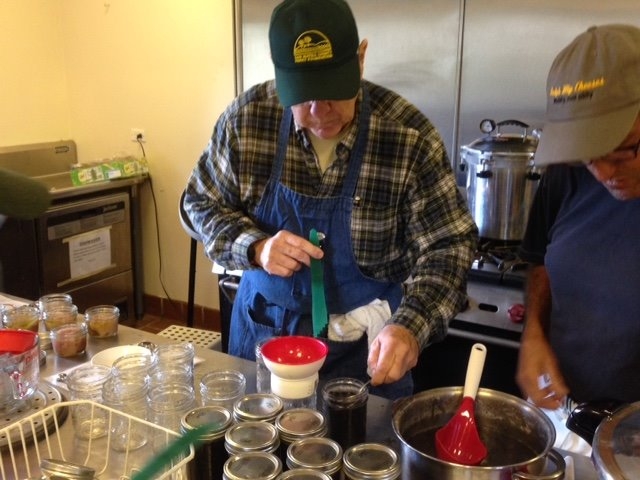
“People are chomping at the bit for this course,” said Virginia Bolshakova, UC Cooperative Extension director for San Mateo and San Francisco counties, who is trying to build the local Master Food Preserver Program slowly. “I have a feeling we're going to have to turn away 75 percent of the people that apply this time around! Our phones are ringing off the hook about this program.”
The program is currently located in 16 counties and expanding.
“We are hiring a staff person to move things forward and expect to have more resources for existing UC Master Food Preserver programs in the near future,” said Missy Gable, UC Cooperative Extension statewide Master Food Preserver Program co-director and UC Master Gardener Program director.

Most of the 46 MFP volunteers are in west Los Angeles and hold workshops at farmer markets, do demonstrations at community gardens and staff booths at the Los Angeles County Fair. They have begun reaching out to low-income residents and high school students.
“Some of our UC Master Food Preserver volunteers are working with high school students,” said Rosales. “A lot of schools now have gardens and one of the high schools has a culinary arts program and a beautiful new kitchen to prepare students for careers in the food industry. MFP volunteers have been teaching students how to dehydrate herbs and cook with herbs and dehydrate kale to make kale chips. They are also teaching jams and jellies classes.”
In Orange County, UC Master Food Preserver volunteers are working with UC Cooperative Extension's 4-H Youth Development Program to create a Junior Master Food Preserver Program for youth. One goal of the program would be to give students an opportunity to earn a certificate in food preservation that they can put on college or job applications.
For more information about the UC Cooperative Extension Master Food Preserver Program, visit http://mfp.ucanr.edu. To find an MFP program near you, visit http://mfp.ucanr.edu/Contact/Find_a_Program.
In the video below, Missy Gable, talks about plans for UC Cooperative Extension's statewide Master Food Preserver Program.
.
To watch Susan Algert, UC Cooperative Extension advisor, demonstrate safe canning practices in a video, visit https://www.youtube.com/watch?v=SeoymcsLWlg.
- Author: Jeannette E. Warnert

Butler was city-raised back East and became enamored by the local food movement, urban agriculture and farmers markets in California's Bay Area. She first ventured to a county fair at the age of 31. When she did, she was enchanted by girls in the livestock barn dressed in snow-white uniforms tending goats.
“When I first learned about 4-H, I thought I had found a genuine American relic, a throwback to a simpler time,” Butler wrote. “I couldn't have been more wrong.”
Butler forged relationships with a handful of suburban California 4-H members raising livestock, though she noted in the book that animal husbandry is just one aspect of today's 4-H program.

Butler visited the homes of 4-H members and attended their meetings. She trailed 4-H'ers as they fed, watered, and walked goats, sheep and pigs. She sat through long, hot competitions and auctions at county fairs. She befriended the parents who were cheering their children from the sidelines.
“The kids were fascinating individuals,” Butler said. “They were regular teenagers in addition to being experts in showing goats, sheep or pigs. I wanted to get their personalities across, how they looked and what motivated them, rather than just their participation in a club.”
Allison Keaney, 4-H program representative for UC Cooperative Extension in Marin County, said she enjoyed the book.
“I appreciate that she (Butler) has gotten into the essence of our program, all the wonderful things that come out of 4-H: communication skills, interpersonal skills, managerial skills,” Keaney said. “She touches on what 4-H is providing to young people that they are not getting at school.”
In the book, Butler recounted the stories of two 4-H'ers who were excelling in their 4-H projects, but not doing as well in their structured school settings. One is Anthony, who is struggling with math class, but managing quite well when calculating the amount of food his animals need based on their weight.

“But that version of Allison is hard to reconcile with the one that I am getting to know – the confident, knowledgeable and outgoing 4-H Allison,” Butler wrote.
Keaney said she recommends the book for 4-H leaders, classroom teachers and after-school program facilitators.
The UC Agriculture and Natural Resources program representative for 4-H animal science education, Sarah Watkins, was quoted several times in the book. Watkins said when she spoke to Butler, she didn't know her comments would be published in a book, but she is pleased with the result.
“She puts 4-H in a very nice light and was able to connect it back to UC,” Watkins said. “Even people who are involved in 4-H at the club level don't always understand that connection.”
Watkins recommends the book for young parents, so they will learn about opportunities for their children.
“It's a great read for anybody to fully understand the depth of modern 4-H,” Watkins said.
UCCE 4-H Youth Development advisor Marcel Horowitz saw Butler's book mentioned in Sunset Magazine. She read the book and found it to be an excellent introduction to the animal side of 4-H. She was also intrigued with the chapter about 4-H in Ghana, Africa.
Butler said she received a grant to travel to Africa, where she met 4-H leaders and members, including a young man in a small community who received hybrid maize seed from DuPont. The superiority of the crop amazed local subsistence farmers, but gave rise to new problems. The seed cost 10 times more than their traditional seed, and, because it is a hybrid, cannot be collected and held over to plant the following year.
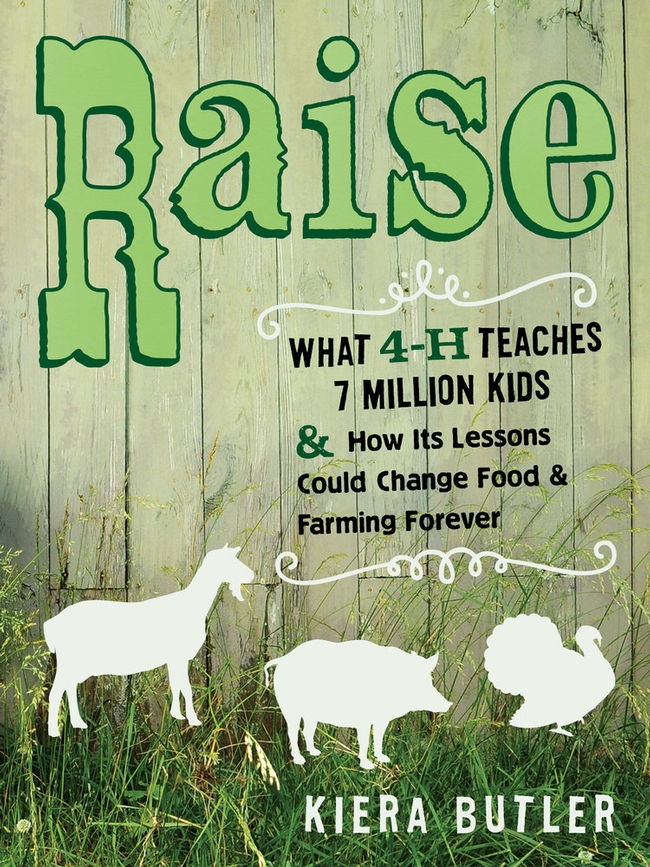
“Please tell DuPoint to give us more seeds; we don't have wigs to fly,” Butler quoted a small town science teacher in Ghana. “We are praying that DuPoint will continue to provide for us.”
Horowitz said she was interested in the ethical dilemma.
“How do you fund 4-H projects without the conflict or bias of the fund source?” Horowitz said.
The Ghana chapter is a short departure for the book, which is firmly rooted in Northern California 4-H animal programs and Butler's discovery that 4-H isn't just for children growing up on farms. 4-H is a way to learn-by-doing in the areas of science, citizenship and healthy living.
“When I try to imagine my original ideal 4-H'er now, I find that I can't do it,” Butler concluded in the book's Afterword. “She has been replaced by all the actual 4-H'ers I know. Luckily for me, they're much more interesting.”
The book is available from University of California Press, Amazon.com and other outlets.
An initiative to maintain and enhance healthy families and communities is part of the UC Division of Agriculture and Natural Resources Strategic Vision 2025.
- Author: Pamela Kan-Rice
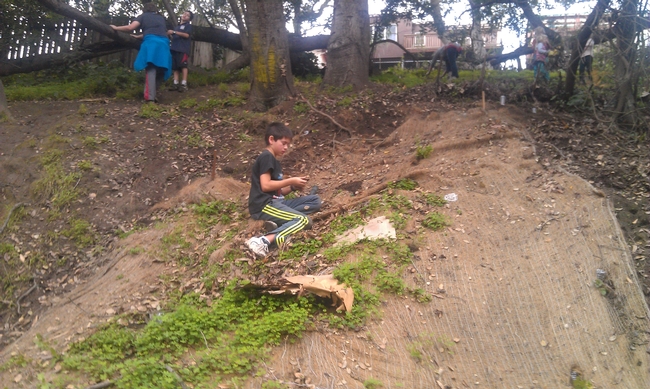
Since adopting the stretch along Sausal Creek in Dimond Park in 2012, 20 4-H members ranging from 5 to 12 years old have been pulling out the invasive plants and replacing them with native plants.
“Friends of Sausal Creek provides us with all the plants and gives us guidance on what should go where,” said Genesta Zarehbin, the 4-H adult volunteer leading the project.
“We planted lots of native plants, such as strawberries, bee plant, ninebark, iris-leaf rush, wood rush, and thimbleberry, that look really cool — but it still gives the appearance of more ivy and spiderwort,” said Zarehbin, who lives in Oakland.

“They have field journals and do research to complete a plant page,” Zarehbin said. “The younger kids do observation -- how many leaves does it have? What color is it? How tall is it? It's a natural discussion when you're out there.”
After removing the invasive, nonnative plants, the 4-Hers had the opportunity to redesign the stretch of trail by choosing and planting natives. At monthly meetings held at the creek, the members regularly weed, water and mulch the plants and pick up trash.
“My kids really get into it,” said Zarehbin, whose children include 9- and 11-year-old sons and twin 6-year-old daughters. “They recognize cow parsnip and soaproot when we go out on hikes. In some areas they'll say, ‘This looks like people are taking care of it.' It gives them a sense of place and how humans shape the environment.”

“The first year, everything died,” said Zarehbin. “The second year, we supplemented the water, and we have a number of plants that survived.”
The creek project is educating the 4-H members, and the 4-H members, in turn, are educating park visitors about the vital work of protecting our natural resources.
“Since our work site is in a very visible location, our 4-H members have been able to enlist the assistance of community members and they frequently have the opportunity to share information with curious onlookers,” said the 4-H project leader.
Zarehbin appreciates the autonomy that Friends of Sausal Creek has allowed, something that enables the kids to develop a sense of ownership. “They let the kids control how they want things to look,” she explained. “The Friends of Sausal Creek are willing to work with young kids and let them work hands-on and contribute in a meaningful way.”
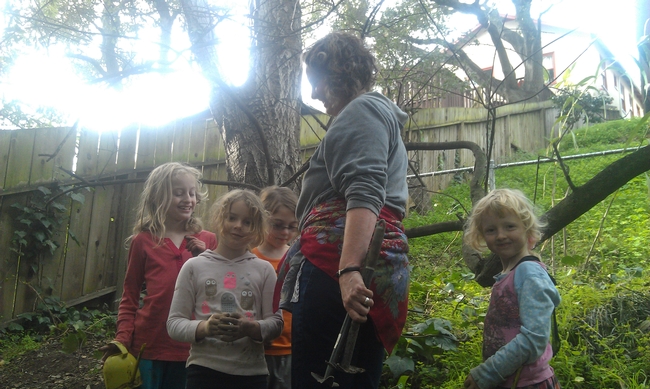
The organization often leads middle school and high school students on field trips, but 4-H is one the few long-term relationships they have with younger children.
Friends of Sausal Creek, which manages a 2600-acre watershed with two permanent full-time staff members, depends on the help of others to preserve and protect the creek.
Groups typically work on an adopted site a few times a year, whereas the 4-H members tend to their site at least once a month. At the last 4-H work day, 30 people participated, said Zarehbin.
“Their recurring workdays enable them to maintain the site – weeding around the native plants and watering them until they are established,” said McAfee. “Their work helps to increase the biodiversity in these urban wildlands.”
McAfee hopes the kids' enthusiasm for nurturing the natural environment will spread to other people in the community.
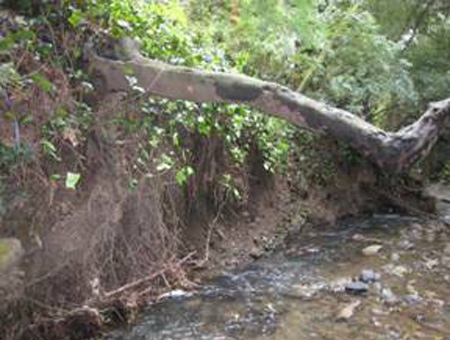
Every year the 4-H club hosts an Earth Day event for a local public school to share what they're learning with other kids their age. Last year, 90 students from Sequoia Elementary School participated, making nature-based crafts and pulling invasive plants to widen the trail. This year the 4-H members have invited Glenville Elementary to join them at Dimond Park on March 12 from 11 a.m. to 1 p.m.
To learn more about participating in 4-H in Alameda and Contra Costa counties, contact May McMann, 4-H program representative at mmcmann@ucanr.edu or (925) 646-6543. To find a UC Cooperative Extension 4-H club near you, visit http://4h.ucanr.edu/Get_Involved/County.
For more than 100 years, the University of California Cooperative Extension researchers and educators have been drawing on local expertise to conduct agricultural, environmental, economic, youth development and nutrition research that helps California thrive. UC Cooperative Extension is part of the University of California's systemwide Division of Agriculture and Natural Resources. Learn more at ucanr.edu.
- Author: Jeannette E. Warnert
Youth in California will know the thrill of the find as they search out and observe birds in their own communities. The children will be taking part in the UC Cooperative Extension 4-H program's pilot study of new birding curriculum developed by the Cornell Lab of Ornithology.
Cornell has long offered “Bird Sleuth” materials for use in schools. Now they have branched out to informal educational settings by writing two new curricula, “Habitat Connections” and “Nature Detectives,” which are being pilot-tested in California, New York and Illinois.

“We'll be getting kids to start observing things in nature, making a record and sharing their data with the repository at the Lab of Ornithology,” Schmitt-McQuitty said. “As we go through the monthly meetings, we'll keep a running total of the species we see.”
The classes aren't just about spotting birds and identifying them. The curriculum weaves in a greater understanding of science and environment with sessions on habitat, the food web and bird survival. Each meeting begins with an optional one-hour bird hike, adding outdoor exercise and nature observation to the science activities.
Over the course of the program, the children will identify a habitat need for wildlife at Hollister Hills. At the final class, they will be out in the field addressing the need by placing nesting boxes, planting native plants, removing invasive species or some other habitat improvement.
Other California counties involved in the pilot study are Mendocino, Lake, Sonoma, San Mateo, Santa Cruz, Monterey, San Luis Obispo, San Diego and Orange. Cornell received a grant from the Noyce Foundation to create and test the curriculum. Representatives from the Ithaca, N.Y., school traveled to California to offer train-the-trainer instruction to 4-H advisors, program representatives and volunteer project leaders.
The curriculum comes in two versions: Nature Detectives, the one to be implemented by Schmitt-McQuitty in San Benito County, and Habitat Connections, which is adapted for afterschool programs.
4-H community educator in Orange County, Jason Suppes, will coordinate the pilot study of Habitat Connections in an Anaheim affordable housing development, Pradera Apartment Homes. Unlike Nature Detectives, in which each monthly class builds on previous lessons, Habitat Connections lessons stand on their own. The format is ideal for the Pradera program, which doesn't attract all the same children to each meeting.

“I don't expect the kids to all become avid birdwatchers, but I'll be pleased if they are able to identify one or two birds in their community,” Suppes said. “They'll get a greater sense about the environment where they live and what they can do to have an impact on the environment.”
The majority Pradera residents are of Latino descent, and most have had few opportunities to learn about nature. Because of the shifting demographics in California to a population with Latinos representing the largest segment, the stewardship of the state's open spaces and public lands could be passed to people who haven't had access or developed an interest.
“Some of these kids never leave their city block,” Suppes said. “Everywhere in the county, we're within 15 miles of the mountains or the ocean. The majority have never seen either one. In 4-H, we're shaping a new generation of land stewards.”
An initiative to maintain and enhance healthy families and communities is part of the UC Division of Agriculture and Natural Resources Stratetic Vision 2025.



